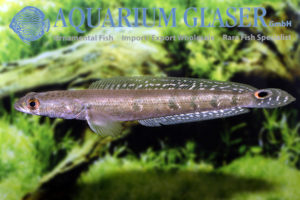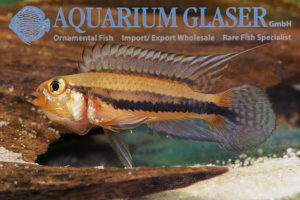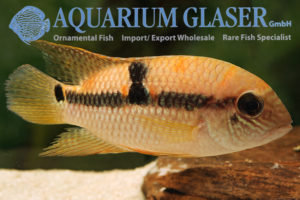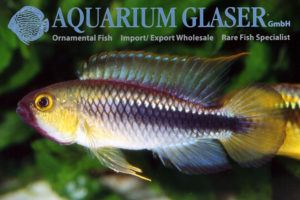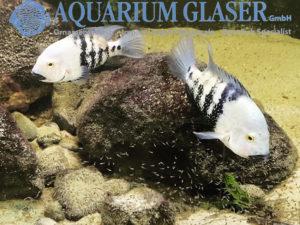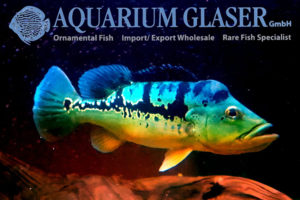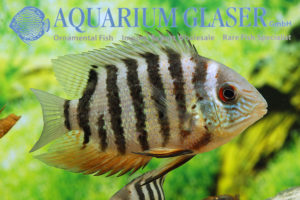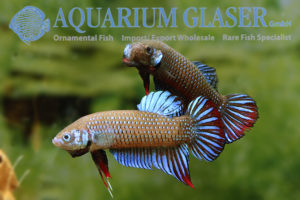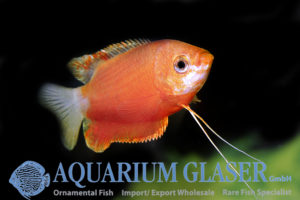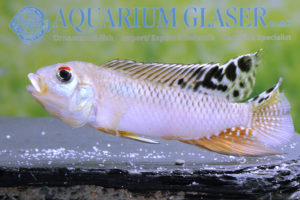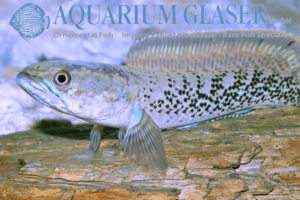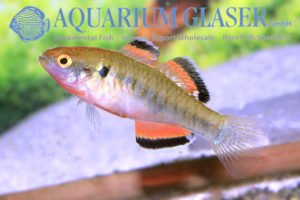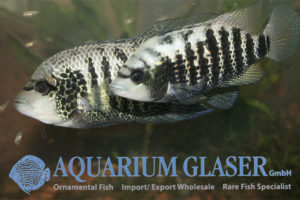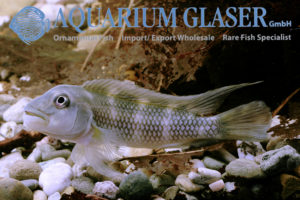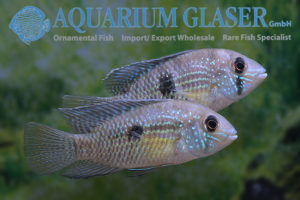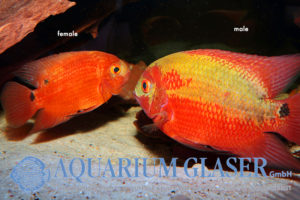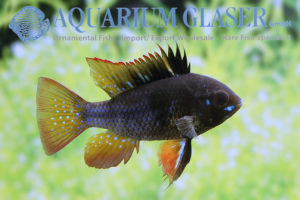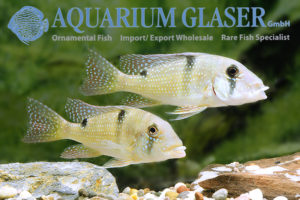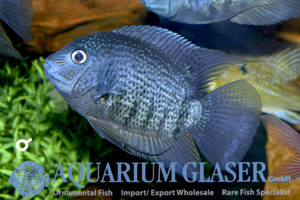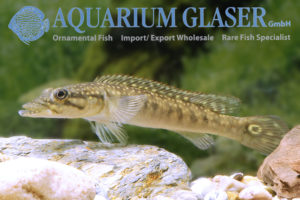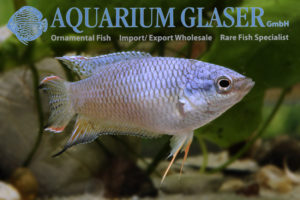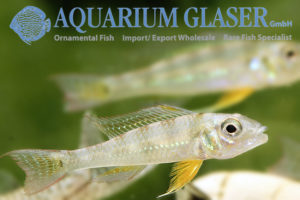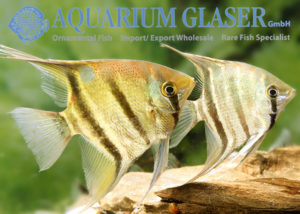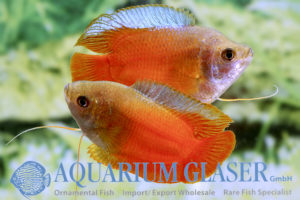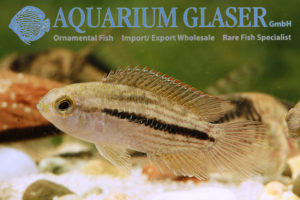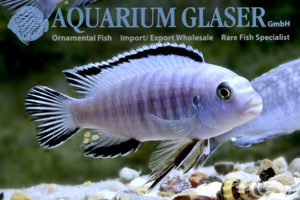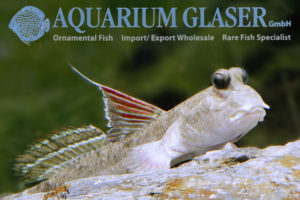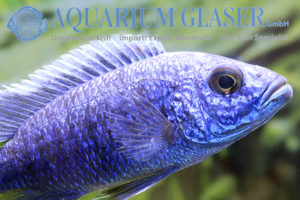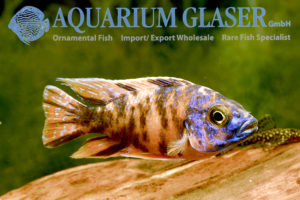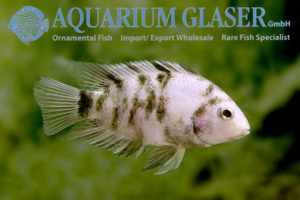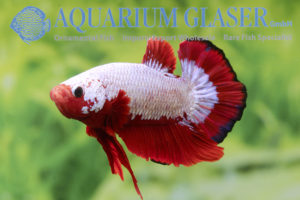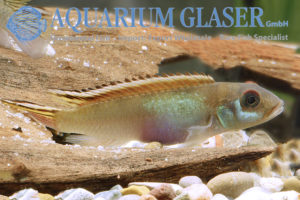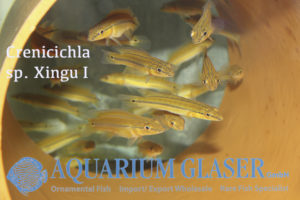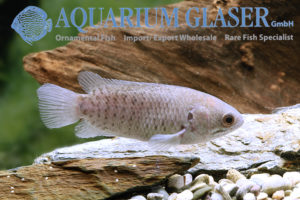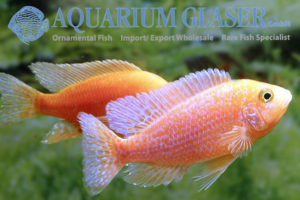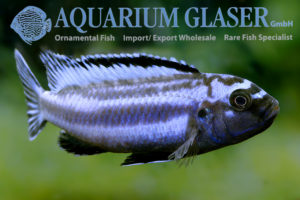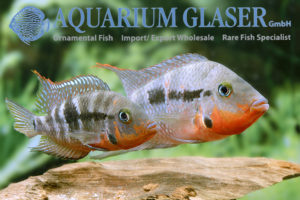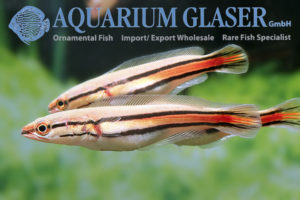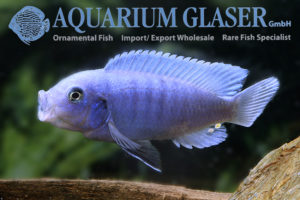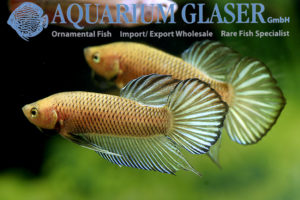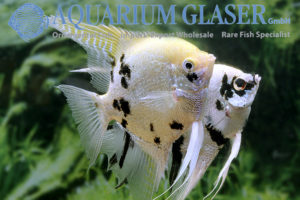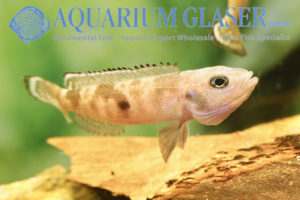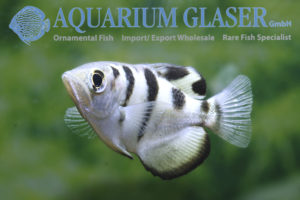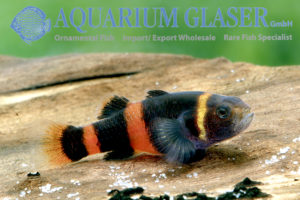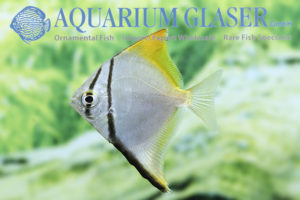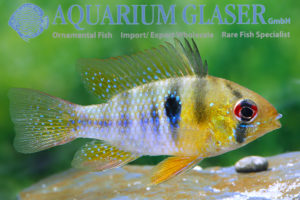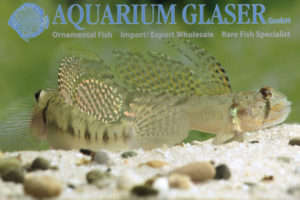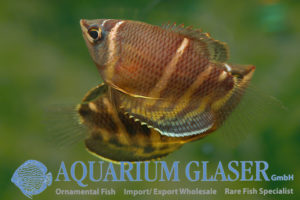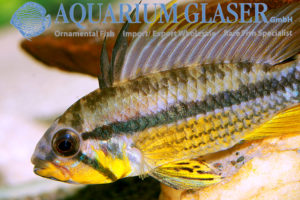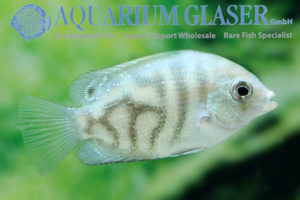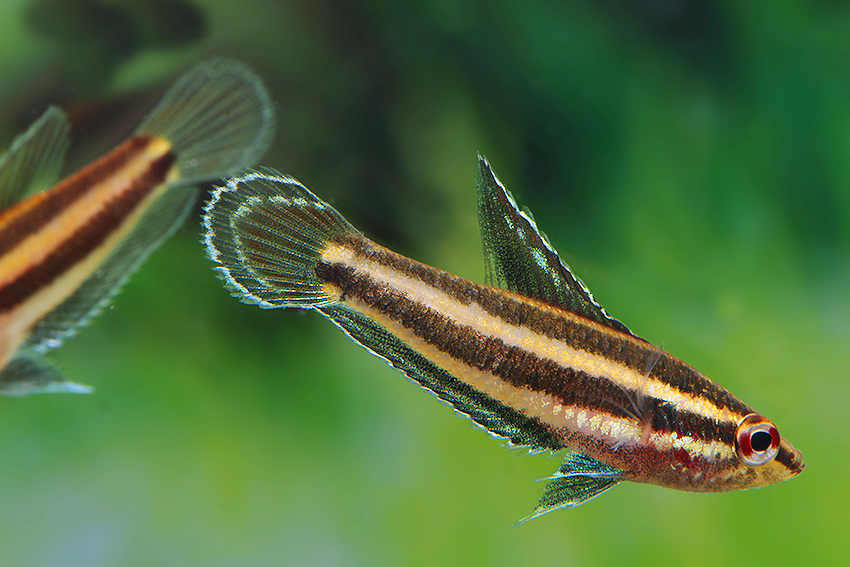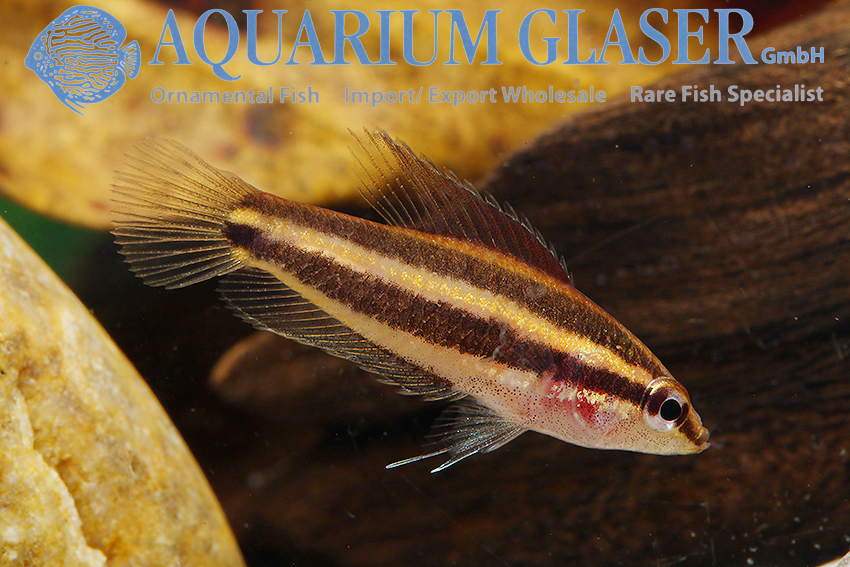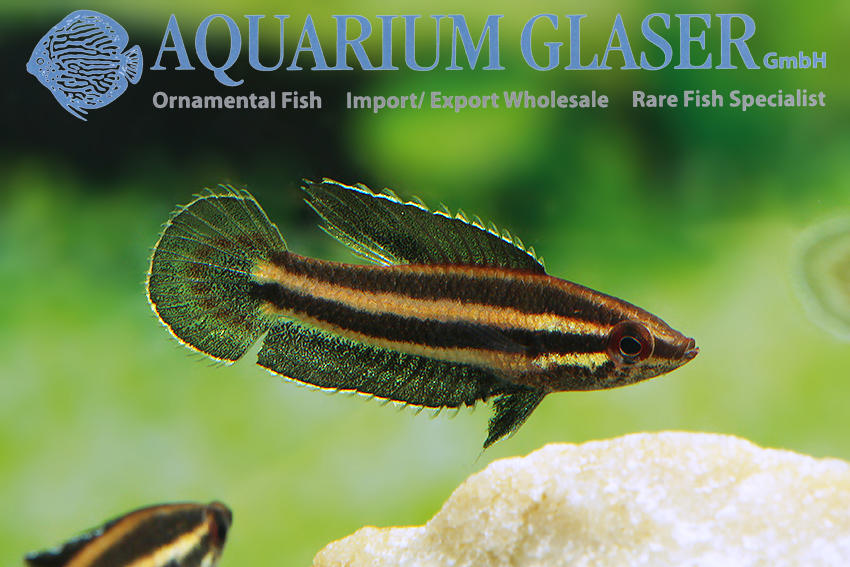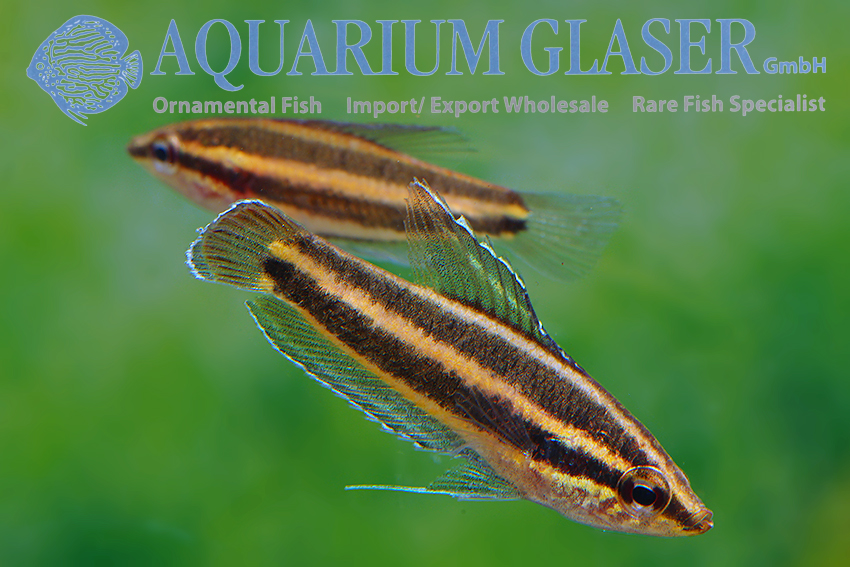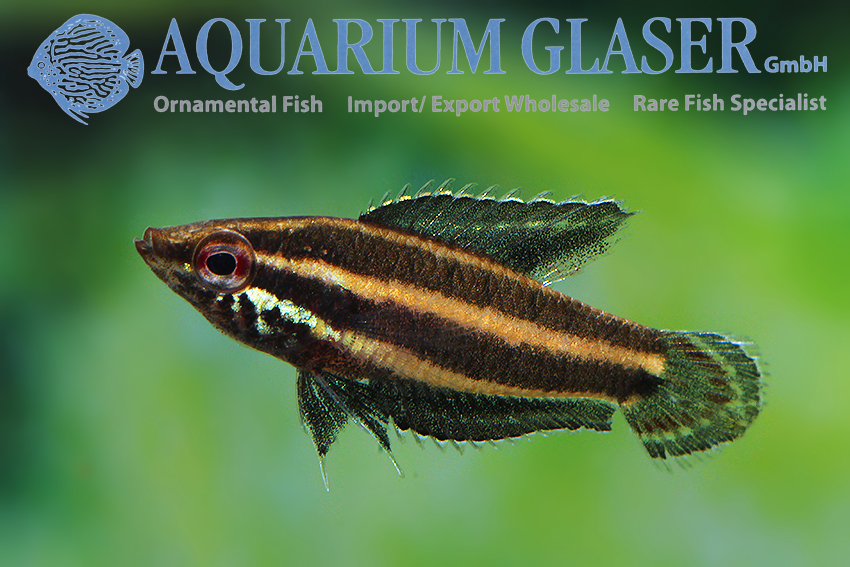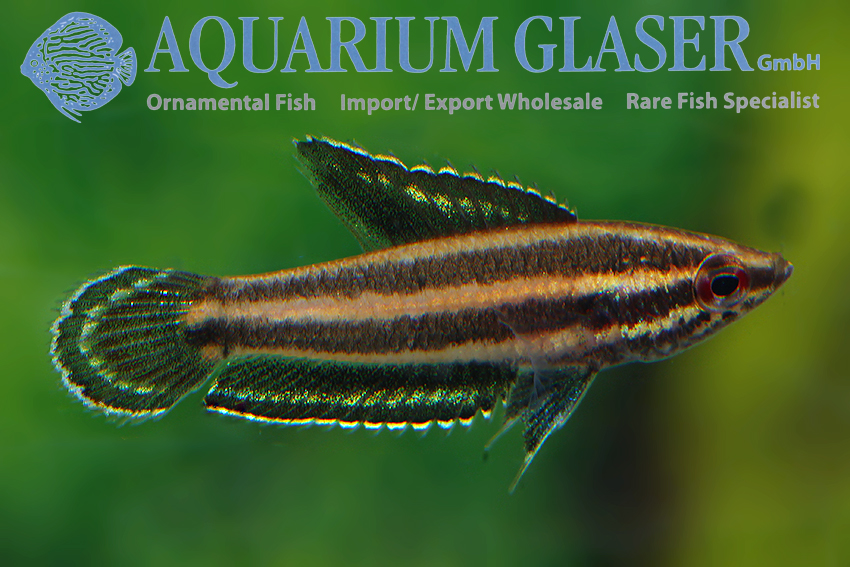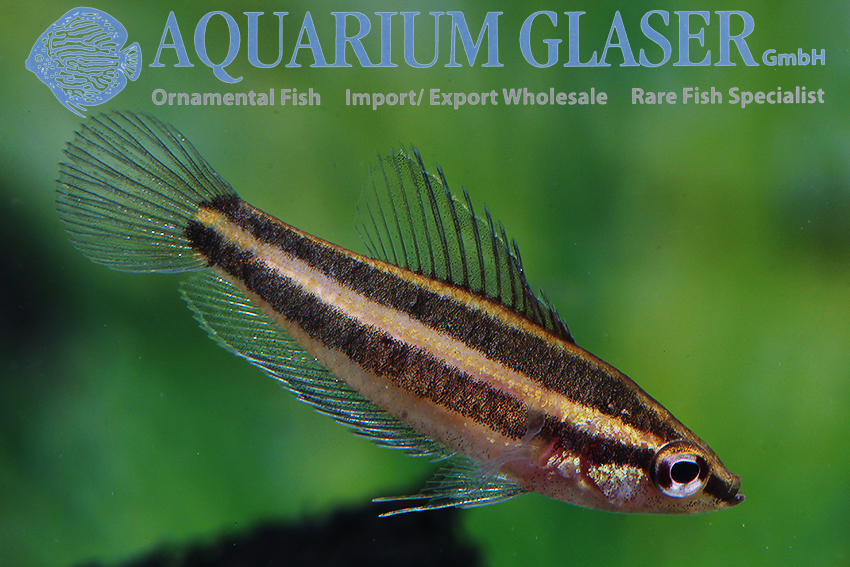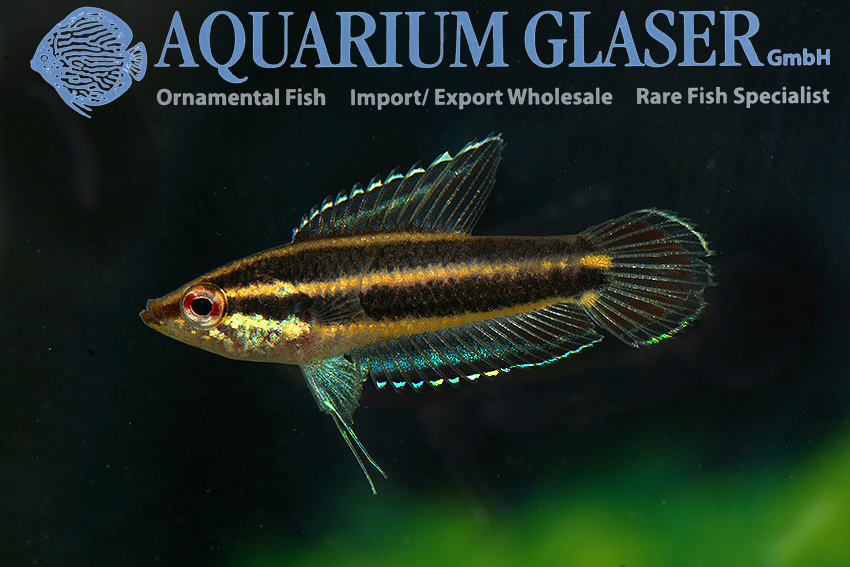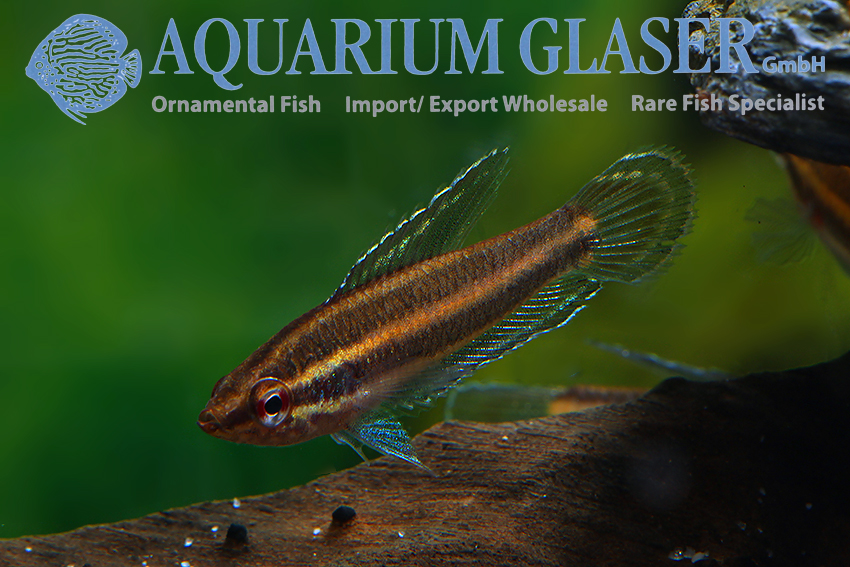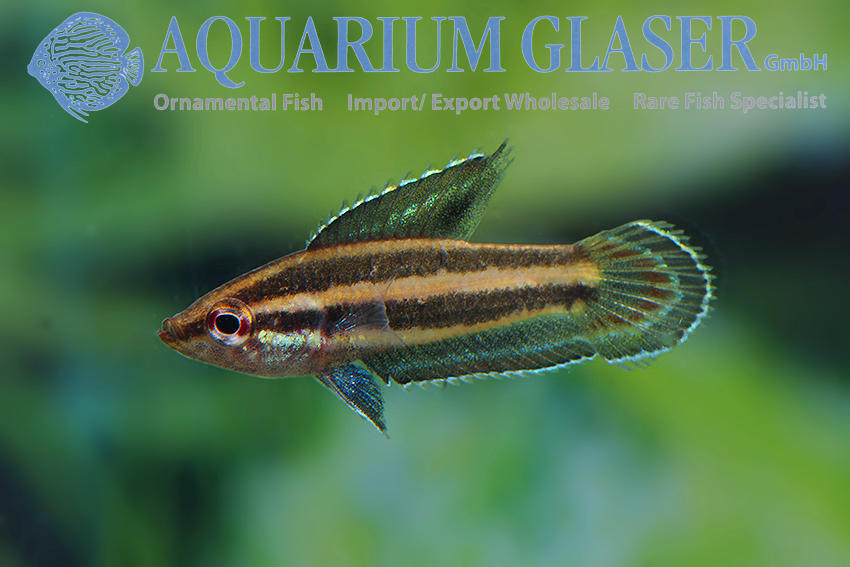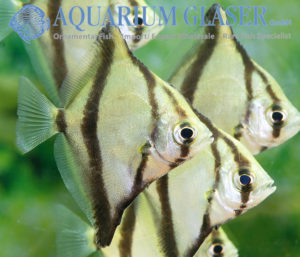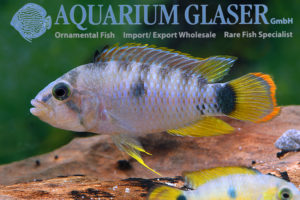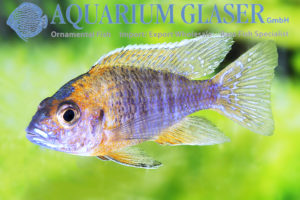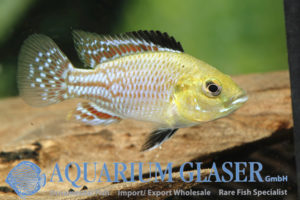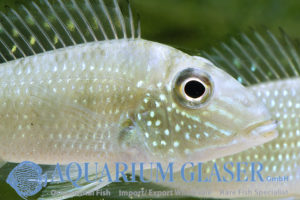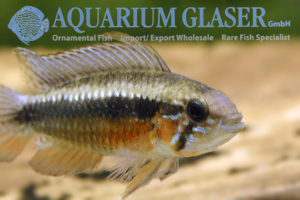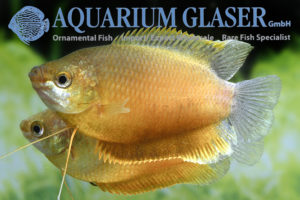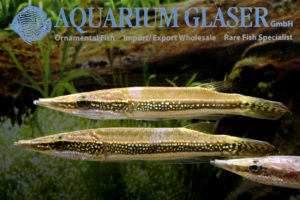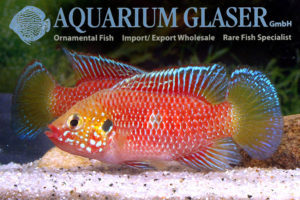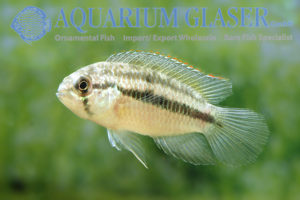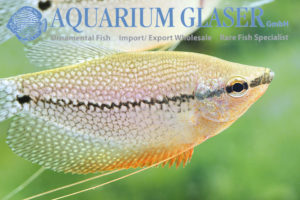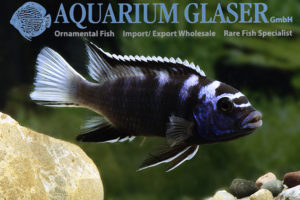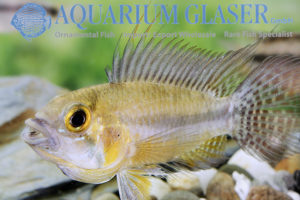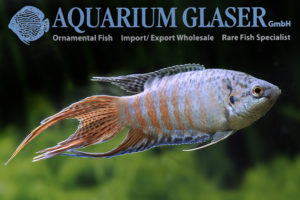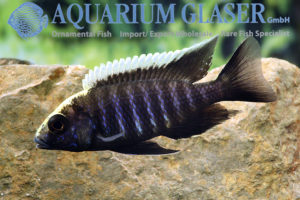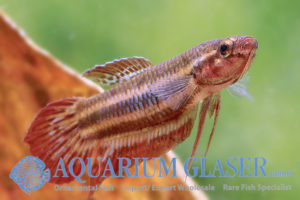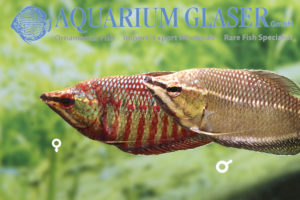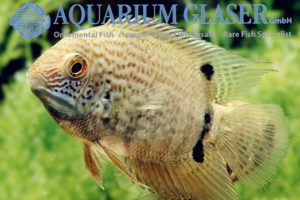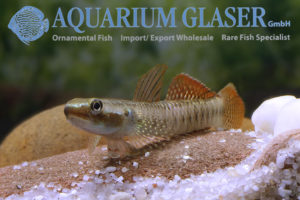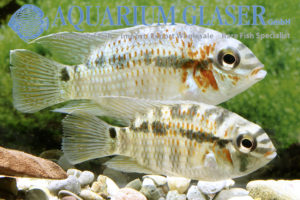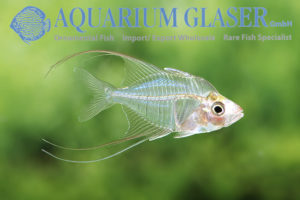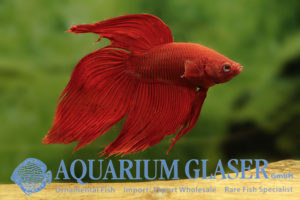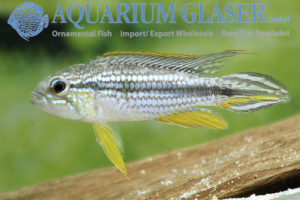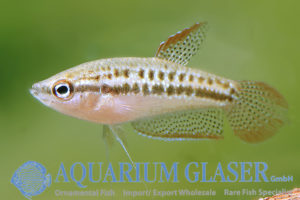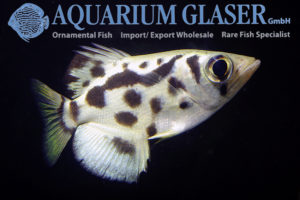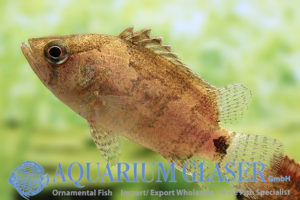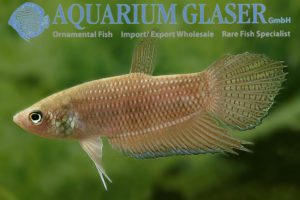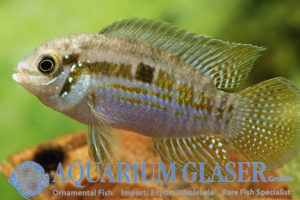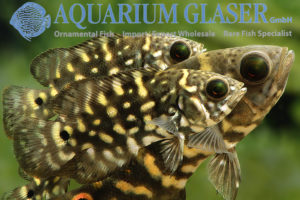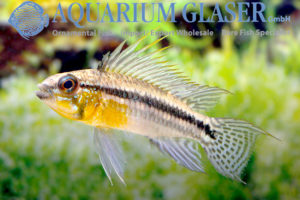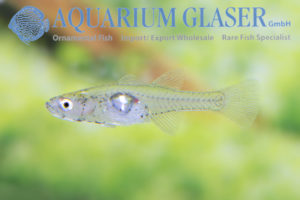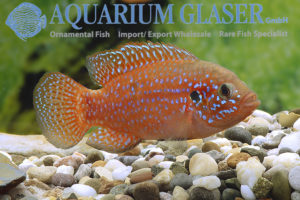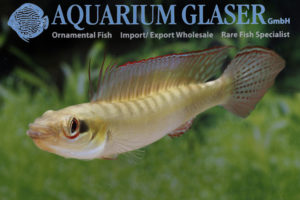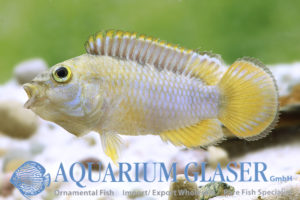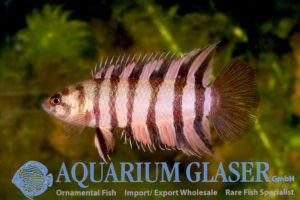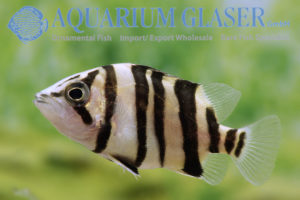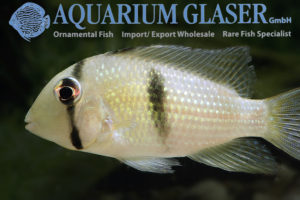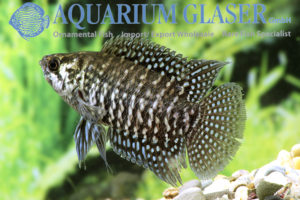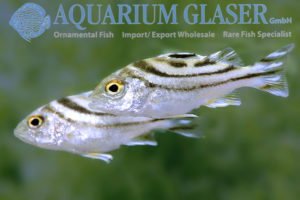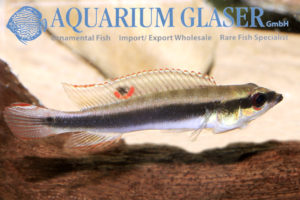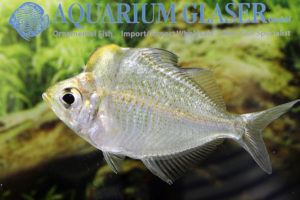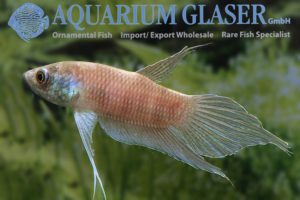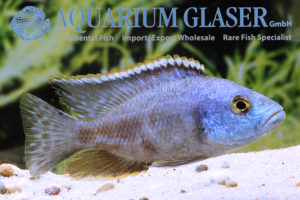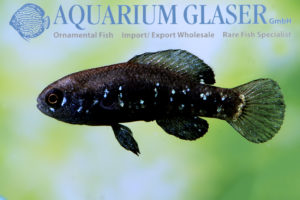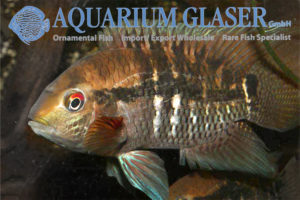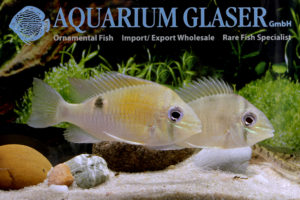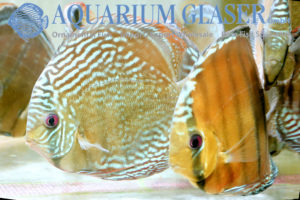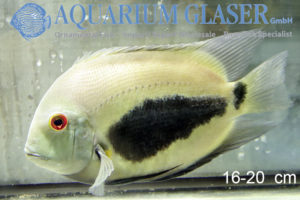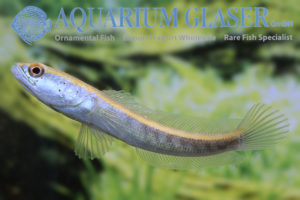The largest and most splendid of all snakeheads belong to the relationship of Channa marulius. This species occurs in India and attains a maximum length of about 120 cm. The largest specimen ever collected is said to have had a length of 183 cm and a weight of 30 kg. But most often the fish […]
25. Perchlike fishes (903)
-
-
Apistogramma diplotaenia German bred
The double stripe (= the translation of the word diplotaenia) is still a rare occurrence in the aquarium. For successful breeding you have to reach pretty deep into the bag of tricks of water chemistry and the animals are also relatively unproductive. This unusual Apistogramma species originates from the black water of the Rio Negro, […]
-
Aequidens superomaculatum
For the first time we were able to import a beautiful Aequidens from Venezuela, which is probably Ae. superomaculatum. This species has been described scientifically only a few years ago – in 2015. Unique in the genus and also giving the name (superomaculatum = with a spot above) is the combination of a continuous lateral […]
-
Apistogramma sp. Wilhelmi
More than 20 years ago (1999) Mario Wilhelm brought back from an expedition to Brazil for the first time this beautiful dwarf cichlid from the Rio Abacaxis. An alternative name to Apistogramma sp. Wilhelmi is therefore A. sp. Abacaxis. This river, a well known area for discus fishes, belongs to the drainage of the Rio […]
-
Astatheros macracanthus (formerly: Cichlasoma m.)
There is no doubt that Astatheros macracanthus is a fish for connoisseurs. This 20-25 cm long cichlid is distributed quite widely from southern North America to Guatemala and El Salvador. The species was scientifically described already in 1864, but in the aquarium it has always remained an absolute rarity. The reason is clear: in the […]
-
Cichla ocellaris x melaniae Hybrid
Few fish show as clearly how dynamic things can get in aquaristics as Cichla. These large cichlids are among the most popular food fish in South America, but until the turn of the millennium they were not considered very suitable for aquarium care: they were considered too large and too sensitive. In the meantime, however, […]
-
Heros sp. Curare Bred
For the first time we could import this magnificent Heros from Venezuela in 2016. The animals should originate from a Rio Curare, therefore the name; however, no Rio Curare is known to us. We suspect the Rio Ventuari as origin. The fish are extremely colorful, otherwise everything speaks for the fact that it concerns the […]
-
Betta imbellis
For many Betta imbellis is the prettiest wild fighting fish at all. Of course, “the” Betta imbellis does not exist at all, because the widespread species looks somewhat different everywhere. It is the sister species to Betta splendens and in fact no human being is able to distinguish completely decolorized specimens of both species from […]
-
Colisa labiosa Ruby Red
Besides the orange colored breeding form of this gourami from Burma (see https://www.aquariumglaser.de/en/fish-archives/colisa-labiosa-orange-2/) there is also a very attractive, deep red colored breeding form. In order to keep these wonderful animals in their bright coloration permanently, it is necessary to provide certain types of food (e.g. Cyclops, Spirulina or also special flake food). Without the […]
-
Nanochromis cf. teugelsi
We have received beautiful offspring specimens of this magnificent Nanochromis from the Congo. Since the experts are not yet agreed whether this species is a color variant of Nanochromis teugelsi or a different species, we have chosen the name Nanochromis cf. teugelsi. The beautiful dwarf cichlids reach a length of about 7 cm in the […]
-
Channa stewartii
This snakehead, often traded under the name Channa cf. barca, originates from the northern Indian province of Assam. C. stewartii can reach a length of up to 30 cm (usually around 20 cm) and as a predatory fish should only be kept along with fish that are at least 2/3 of its body length. Besides […]
-
Hypseleotris compressa
Sometimes it happens that even we run short in finding superlatives: in any case this fish deserves to create one! It is so beautiful…. H. compressa is a sleeper goby that lives free swimming in the water column. In contrast to many other gobies this fish is not a bottom dweller. In Germany the genus […]
-
Mayaheros beani (formerly: Cichlasoma b.)
Origin: Rio San Christobal = Laguna El Camalote, San Blas, Nayarit, Mexico The small town of San Blas, where the Rio San Christobal empties into the Pacific Ocean, is considered the northernmost place with a tropical climate on the Pacific coast of Mexico. The name Laguna El Camalote was originally applied to a marshland southeast […]
-
Steatocranus gibbiceps
Our current Congo import contains again two species of the funny humphead cichlids: Steatocranus casuarius and S. gibbiceps. They look very similar to each other at first sight (and we can hardly avoid in wholesale that sometimes a casuarius is among the gibbiceps and vize versa), but when looking closely you can see that in […]
-
Andinoacara latifrons Rio Atrato
This beautiful cichlid has been swimming in the world’s aquariums since 1906 and has been delighting for generations with its varied behavior and beautiful looking brood care. The animals are typical open breeders with parent family, i.e. both parents lead the numerous brood. Confusion gave in the course of time due naming. For a long […]
-
Hypselecara temporalis OYAPOC
The Emerald cichlid has become a bit out of fashion. This is a quite sad thing, for this impressive large cichlid – males can become up to 30 cm long, females always stay much smaller – is one of the most beautiful species of cichlid of South America. Once more we can offer now German […]
-
Mikrogeophagus ramirezi “Black”
Black butterfly cichlids have been around for a few years and many breeders do an excellent job on them, so that really beautiful and healthy animals come on the market. We have now received a strain of Black Rams, in which the blue of the scales is limited to the rear half of the body […]
-
Geophagus harreri
In very small numbers we have received this beautiful Geophagus as German offspring. The species reaches a maximum length of 20-25 cm and is exclusively found in the inlet of the Marowijne River, the border river between French Guyana and Suriname. One of the tributaries of the Marowijne is the Maroni River, known to cichlid […]
-
Heros sp. Madeira
The Rio Madeira is a right tributary of the Amazon River and is considered the largest tributary in the world. Its origin is in Bolivia where it is formed from the confluence of the Rio Beni and the Rio Marmoré. It flows into the Amazon in Brazil at Itacoatiara. The Rio Madeira is a white […]
-
Crenicichla jegui
The pike cichlids (Crenicichla) are with 94 accepted species (and there are still a large number of undescribed ones) the most species-rich genus of cichlids at all. One of the most distinctly different species is Crenicichla jegui from the Rio Tocantins drainage. There the fish lives very hidden and was therefore discovered only when the […]
-
Macropodus spechti “Royal Blue”
For the first time we can offer this magnificent breeding form of the black paradise fish. Our breeder writes about it: How did I become aware of these fish: In 2019, I saw a picture of blue paradise fish from Vietnam in a Facebook group for paradise fish lovers by chance. Being skeptical at first […]
-
Biotoecus dicentrarchus
The dwarf cichlids of the genus Biotoecus were shrouded in mystery for decades. The first species, B. opercularis, was scientifically described as early as 1875. It originated from the Amazon River basin in Brazil, a well-collected area for aquaristic purposes, and yet the first import was not accomplished until the mid-1980s and early 1990s. The […]
-
Pterophyllum leopoldi (“dumerilii”)
This season we received especially attractive Pterophyllum leopoldi from Brazil. Unfortunately, the animals do not like the photo tank at all and show there only a fraction of the wonderful colors – a magnificent green shimmer all over the body and a very nice red tone in the back – that well acclimated animals of […]
-
Colisa lalia “Flame Red
Only from few breeding forms is so well known, when they originated, as with Colisa lalia “Flame Red”. At the same time the fish decorated the covers of all aquaristic journals worldwide in the early 1980s, so sensational were they found. The animals were bred in the Lim Choa Kang area of Singapore, a rural […]
-
Nannacara taenia
Nannacara taenia is with a maximum of 5 cm total length one of the smallest cichlids at all. Additionally it is absolutely peaceful and therefore an ideal fish for community aquariums. The species was described in 1911 from aquarium fishes believed to have been exported via Manaus. However, these animals were never found again in […]
-
Chindongo socolofi (= Pseudotropheus s.)
What is the saying? Who does not ask, remains stupid. In the case of the rock cichlids of Lake Malawi, the so-called Mbuna, it is undoubtedly the garish, bright colors that initially attract attention and led to the much quoted comparison with coral fish. In fact, the colors of the mbuna have primarily the same […]
-
Periophthalmus novemradiatus
The Indian Dwarf Mudskipper, Periophthalmus novemradiatus, is the ideal aquarium mudskipper with its usually 6 cm length (in literature up to 10 cm are given, but we have never seen such large specimens, probably this statement is based on confusion with other species). In addition to its small size, it has many other favorable attributes: […]
-
Sciaenochromis fryeri
Many rock dwelling cichlids (mbunas) of Lake Malawi live isolated on certain rocky shores. These are often miles away from other rocky biotopes, so geographic isolation leads relatively quickly to local color variations. Other cichlids of the lake, such as Sciaenchromis fryeri, are not bound to specific biotopes and occur accordingly throughout the lake. Although […]
-
Aulonocara Orange Blotched
Everything there is to say about these wonderfully colorful cichlids has already been said about another breeding variety, the Aulonocara Dragon Blood: https://www.aquariumglaser.de/en/fish-archives/aulonocara-dragon-blood-2/ The Orange Blotched are now one of the most common Malawi cichlids on the market. No wonder: there is hardly a fish species, which shows such a variety of bright colors, like […]
-
Amatitlania (formerly Cichlasoma) nigrofasciata Marble
The convict cichlid Amatitlania (formerly Cichlasoma) nigrofasciata is really not a novelty anymore: it has been kept and bred in aquariums since 1939. The first aquarium animals of this very widely distributed fish in Central America came from the lakes Atitlan and Amatitlan in Guatemala. The genus to which the convict cichlid currently belongs was […]
-
Betta splendens Hellboy II
Some time ago we introduced a short-finned fighting fish breeding form (“Pla Kat”) of Betta splendens as “Hellboy”. (https://www.aquariumglaser.de/en/fish-archives/betta-splendens-pla-kat-hellboy-and-giant-halfmoon/). Now we have received Pla Kat under this name from Thailand again, but they differ from the first Hellboys in color and fins. The new Hellboys have a halfmoon tail fin, which means that when the […]
-
Nanochromis parilus wild
Since a long time we received again a Congo import. Beside many other interesting fishes and novelties also the good old acquaintance Nanochromis parilus was among them. These beautiful, assertive dwarf cichlids are very common in the region around the capital Kinshasa. It is astonishing that they were described by science only in 1976. In […]
-
Crenicichla from the Rio Xingu
In the 1990s, when the large river cichlids of Brazil experienced a certain boom, also four Crenicichla species came to Europe for the first time, which were named Crenicichla sp. Xingu I – IV due to the lack of availability of a scientific name. All four grow quite large by ornamental fish standards, you have […]
-
Anabas testudineus
There are many criteria, why to choose this or that fish for the aquarium. Those who like colorful fish should avoid Anabas. But who likes to observe biological peculiarities is well advised with the climbing perch. General information about Anabas can be found here: https://www.aquariumglaser.de/fischarchiv/anabas_de/. We have now once again imported climbing perch from Bengal. […]
-
Aulonocara “Dragon Blood”
Aulonocara are a specious and colorful genus of Malawi cichlids; because of their brightly colored dress they are called “peacocks” in English. They are small-animal eaters that selectively ingest small chunks of food. Another group of cichlids in Lake Malawi feeds on the algae and the microorganisms (= Aufwuchs) they contain, which grow on rocks. […]
-
Melanochromis johannii
The bluegray mbuna or the electric blue johanni (Melanochromis johannii) was imported so early (1972) from Lake Malawi for the hobby that one still made the effort to invent a popular name for it. This was later abandoned in view of the great number of species. In the wild, these fish, like many other Aufwuchs-feeding […]
-
Thorichthys meeki “Rio Candelaria”
The Rio Candelaria is a lowland river in Central America. It originates in northern Guatemala and flows through regions there and in southeastern Mexico whose jungle landscapes were almost untouched by man for a long time. The Rio Candelaria gained sad fame because the conquistador Hernán Cortez had the last Aztec ruler Cuautémoc, a fierce […]
-
Channa micropeltes
One of the most beautiful freshwater fishes of all is Channa micropeltes. This snakehead lives in groups and its favorite pastime is eating. It is therefore constantly on the lookout for food and swims lively in a shoal through the aquarium. Although every word up to this point is true, it is still only half […]
-
Bright blue Maylandia from Thailand
The zebra cichlids of Lake Malawi were among the first cichlids to come to us from this great lake in the 1960s. At that time they caused real enthusiasm storms. Aquarists had no idea of the enormous diversity of species and forms that exist there. So the zebras were simply called “Pseudotropheus zebra” after one […]
-
Betta splendens Pla kat Yellow cheek Spadetail
The first documented domesticated form of the Siamese fighting fish (Betta splendens) was a Spadetail. That was in 1849. At that time certainly fighting fishes were bred for a long time, but they resembled more or less the wild fishes and were selected only for their fighting characteristics. The appearance of these animals was a […]
-
Angelfish XL
Fully grown angelfish of the various breeding forms are comparatively rare in the trade. The reasons are obvious: The breeding is time and space consuming, because they are still cichlids, which demand a certain individual space for themselves. That’s why XL angels have to be comparatively expensive. But occasionally such animals are in demand and […]
-
Lepidiolamprologus attenuatus
The species of the genus Lepidiolamprologus belong with about 15 cm final length to the largest representatives of the Lamprologus relationship in Lake Tanganyika. They are predatory animals that like to feed on small fish. Like so many predators, they are remarkably peaceful toward fish that do not serve as food. In the lake, Lepidiolamprologus […]
-
Toxotes mekongensis
Archerfishes can be divided into two groups: those that live in the brackish water of estuaries, reproduce there as well (all archerfishes are free spawners without brood care) and can also live in pure seawater. These species are therefore widely distributed along the coasts of the Indo-Pacific from India to Japan and Australia. And then […]
-
Brachygobius doriae
This is probably the most beautiful species of the bumble bee gobies, because the males (also some females) develop a splendid orange-red in the rear half of the body. The females are mostly yellow in color, but they are easily recognized by the comparatively smaller head regardless of coloration. The species was and still is […]
-
Monodactylus argenteus
Moonies are magnificent brackish water fish. In pure fresh water they should be kept only temporarily, if possible, because they are very sensitive there. If it has to be freshwater, then the pH value must not drop below 7 and the nitrate value must not rise above 50 mg/l, nitrite is harmful even in very […]
-
Mikrogeophagus ramirezi wild
Because of the enormous popularity of the butterfly cichlid or blue ram (Mikrogeophagus ramirezi), there are mainly offspring and breeding forms on the market. Also the wild-colored offsprings differ clearly from the wild species: they are considerably larger (4-5 cm body length without caudal fin compared to 2-3 cm with wild-caught fish) and at the […]
-
Oligolepis acutipennis
Oligolepis acutipennis is one of the most widespread gobies of the Indo-West Pacific. The species, which can grow up to 15 cm long, is distributed from South Africa via East Africa, the Persian Gulf, Madagascar, Indonesia and along the entire coast of Southeast Asia to Japan. From this wide distribution one can easily conclude that […]
-
Sphaerichthys osphromenoides
The chocolate gourami (Sphaerichthys osphromenoides) still belongs to the legendary ornamental fish species. Although the species is common in the wild and other fish of the same habitat (e.g. harlequin barbs) do not cause significant problems in the aquarium, it is a gamble whether chocolate gouramis will do well there. Possibly this is related to […]
-
Apistogramma allpahuayo
For a long time this beautiful dwarf cichlid from the basin of the Rio Nanay in Peru sailed under the name “cf. juruensis” or “sp. Black Chin”. Only the scientific description of the species in 2012 put an end to the confusion. Great similarity exists to A. juruensis and A. cacatuoides. From both species living […]
-
Etroplus suratensis Bred
Mostly we receive the Indian Pearl Cichlid (Etroplus suratensis) as wild catch from South India (formerly also from Sri Lanka) or as German offspring from zoo aquariums. Now, for the first time, we have imported bred ones from Indonesia; some specimens of these offspring do not show a stripe pattern, but have an irregular bow […]
-
Monodactylus sebae
The African Mono is widely distributed along the tropical Atlantic coast of Africa. As a completely euryhaline fish, it can freely change between fresh, brackish and seawater; it prefers to stay in brackish water. In its native range M. sebae is a common fish and is caught there for food. In the past, aquaristic needs […]
-
Apistogramma sp. Oregon
The attractive Apistogramma sp. Oregon comes from the wider surroundings of Iquitos in Peru. Don’t ask us why this one is called “Oregon” – we don’t know that either. It belongs to the closer relationship of A. nijsseni, but differs clearly from this species by the bulky body structure, the large tail spot and a […]
-
Aulonocara “Rubescens”
Do you know the game “Silent Mail”? You play it with at least 10 participants, the more, the better. One of the players thinks up a term and whispers it – inaudible to the others – into the ear of the player next to him. This whispers what he has understood to the next one, […]
-
Pseudocrenilabrus nicholsi
This dwarf mouth-breeder comes from the middle and upper Congo, from where ornamental-fish-imports almost never reach us. Pseudocrenilabrus nicholsi is therefore only available as bred ones. The males are beautiful, the females are rather plain colored. The maximum length is about 7 cm, but also this size is reached rather rarely; the photographed, sexually mature […]
-
Satanoperca sp. aff. jurupari “Tapajos”
Some of the earth-eaters of the genus Satanoperca have frightening names (Satanoperca = devil-perch, Jurupari = devil, Daemon = demon, Lilith = the bride of the devil), but there are only few cichlids that are as peaceful and harmless as they are. The most important thing they need in an aquarium is a part of […]
-
Apistogramma elizabethae
This wonderful dwarf cichlid belongs to the rarest and most wanted species of Apistogramma in the trade. Nevertheless the animals are not very difficult to keep at all. If the fish is kept under the correct conditions it belongs to the hardier species of the genus. There do exist elder reports on the fish that […]
-
Colisa labiosa “Orange”
The identity of Colisa labiosa, a gourami from Burma, is unclear; there is some evidence that the species so named in the hobby is actually not identical with C. labiosa in the sense of the first describer (Day, 1877), but it is much more likely that it is a scientifically not yet named species. But […]
-
Luciocephalus aura
The pikeheads (Luciocephalus) are highly specialized labyrinth fish. They live as predators in blackwaters of Southeast Asia. Only two species are known, the “common” pikehead, which occurs on the Malay Peninsula and in Indonesia, and the Peppermint Pikehead, which is known so far only from the Province Jambi on Sumatra. Currently we are able to […]
-
Hemichromis sp. Red Gabon
Red Jewel Cichlids are gorgeous fishes. Their splendid coloration can be hardly topped. And they have a fascinating behaviour. They form a biparental family, both male and female take carefor the offspring together. No real hobbyist can hestitate to be banned by that look. The only negative aspect of these fishes is: they can be […]
-
Nannacara sp. “Crique Canceler”
The Goldeneye cichlid (Nannacara anomala) is a classic among aquarium fish. Already 80 years ago this species taught the aquarists what emancipation means, because here the female is the absolutely dominant fish. And the female often is only half as big as the maximum 8 cm long male. Dwarf cichlids from the closer relationship of […]
-
Trichogaster leerii WILD – Borneo
The pearl gourami (Trichogaster leerii, Trichopodus leerii) is one of the most popular aquarium fishes at all. It is probably not exaggerated if one assumes millions of individuals in aquariums all over the world. All these fish are bred ones. It is only little known that the pearl gourami belongs to the endangered species as […]
-
Pseudotropheus sp. “Acei” White Tail Ngara
Where does a species start, where does the location variant end? This question is really difficult to answer for some groups of fish, e.g. killies and cichlids from Lake Malawi and Lake Tanganyika. In the case of Pseudotropheus sp. “Acei” from Lake Malawi, the species is not described scientifically. Mostly the light blue, yellow-fin “Acei” […]
-
Apistogramma cacatuoides Yellow wild
The Cockatoo Dwarf Cichlid is one of the most popular members of the genus Apistogramma and found in petshops all over the World. Almost exclusively bred specimens of very colourful sports are traded. These do not appear in the wild. However, “the” wild form of A. cacatuoides does not exist at all. Like so many […]
-
Macropodus opercularis “Blue“
There are no blue paradise fish in nature, they are a cultivated form with a blue back (vs. red-brown in the wild form). When exactly and in whom the first blue paradise fish appeared is not documented. It must have been in the late 1940s or early 1950s, because from then on they were mentioned […]
-
Aulonocara maylandi
The sulphur head aulonocara, Aulonocara maylandi, is one of the most peaceful species of Malawi cichlids. The species reaches a maximum length of 12 cm (male) and 10 cm (female). In the wild these fish only live in two reefs of the south-eastern Lake Malawi, namely Chimwalani Reef (formerly Eccles Reef) and Luwala Reef (formerly […]
-
Betta coccina
Right now we have especially large and beautiful Betta coccina from Indonesia in stock. As the pictures show, this time the males have particularly extensive blue patches on their flanks; the females of Betta coccina generally do not have blue flank scales. Betta coccina can be kept well in groups, but even these comparatively peaceful […]
-
Sphaerichthys vaillanti xxl
From Indonesia we have received extraordinarily beautiful and especially large Sphaerichthys vaillanti. According to our supplier they come from the vicinity of the Danau Senatrum National Park in the part of Borneo belonging to Indonesia called Kalimantan. For more information about this magnificent animal see https://www.aquariumglaser.de/en/fish-archives/sphaerichtys-vaillanti/ Text & photos: Frank Schäfer
-
Heros sp. Manacapuru
Manacapuru is the third largest city in the state of Amazonas in Brazil. It is located about 80 km west of Manaus at the confluence of the Rio Manacapuru and the Amazon. A large, lake-like extension of the Rio Manacapuru near the city is called Lago Cabaliana. From the surroundings of Manacapuru, especially the red-backed […]
-
Stiphodon ornatus
This beautiful freshwater goby was originally described as a subspecies of Stiphodon elegans. It originates from West Sumatra (Indonesia), where it lives in clear streams. Stiphodon ornatus feeds on an Aufwuchs, i.e. it feeds on algae and the small creatures that live in them. In the aquarium any form of dry, frost and live food […]
-
Krobia xinguensis
Only in 2012 this pretty cichlid was scientifically described, before that it was known in the hobby as Krobia sp. “Xingu Red Head”. As the name suggests, the animal originally comes from the Rio Xingu in Brazil. However, the species is only available as bred ones. This beautiful Aequidens relative is the ideal cichlid for […]
-
Gymnochanda flamea
A very wonderful dwarf glassfish reached us from Indonesia: Gymnochanda flamea, the red filamentous glassfish. All Gymnochanda species (G. filamentosa, G. flamea, G. limi, G.ploegi and G. verae) are pure freshwater fish, you should never add salt to the water. Only two species, G. flamea (South-Borneo) and G. filamentosa (Malaysia, Sumatra (?), West-Borneo) have thread-like […]
-
Betta splendens Veiltail
The history of becoming a domesticated animal is hardly researched for many species and is full of secrets, as it is with Betta splendens. There is some evidence that its true domestication only occurred after the collapse of the Khmer Empire in the 15th century. Before that, Betta splendens had been used for fish fights, […]
-
Apistogramma agassizii „Tefé“
There are many colour varieties of Apistigramma agassizii. The species – as it is currently understood – occurs in the complete Amazon river area in Colombia, Peru, and Brazil. The most wanted variety is probably the „Tefé“ variety. It is, however, not really proven that this variety really comes from the Rio Tefé, a right […]
-
Trichopsis pumila
The Pygmy gourami, Trichopsis pumila, is one of the prettiest labyrinth fish. With a maximum length of 4 cm (usually it stays one centimeter smaller) it is a real dwarf fish. The species occurs in Thailand, Laos, Vietnam, and Cambodia. Although the species is an obligatory air breather, so would drown if you block its […]
-
Toxotes blythii
This archer fish that lives exclusively in freshwater originates from Burma. It has been discovered as early as 1860 and received its correct scientific name in 1892. Since then it has not been found anymore. Only in 2004 the first specimens appeared in the international trade and were celebrated as a sensation. These first specimens […]
-
Nandus nebulosus
Via Singapore we have once again received Nandus nebulosus in beautiful, fully grown specimens. The species can, like all other leaf fish, change its colouring very fast and drastically, furthermore each specimen has an individually different marble pattern. Some of our new arrivals have a head profile which is much more pointed than expected from […]
-
Betta apollon
Betta apollon was scientifically in 2006 and comes from forest streams in the hilly country west of Narathiwat in Thailand. The mouthbrooding species belongs to the immediate relationship of Betta pugnax. The fish was named after the Greek god Apollon, who stands for beauty and elegance among other things – an aptly chosen name for […]
-
Laetacara araguaiae
Finally we were able to import once more this charming dwarf cichlid. The fish was known in the hobby under the name of Laetacara sp. “Buckelkopf” ( = humphead) before the scientific description. For more informations, please click https://www.aquariumglaser.de/en/fish-archives/laetacara_araguaiae_en/ For our customers: the animals have code 603002 on our stocklist. Please note that we exclusively […]
-
Astronotus cf. crassipinnis “Bumble Bee”
Currently we import very pretty young Oscars from Brazil, which are offered under the name “Astronotus crassipinnis”. The species A. crassipinnis exists in Brazil, but there is no possibility to check if the species identification is correct. We suspect that the animals are bred ones. The beautiful fish show the typical behaviour of all Astronotus […]
-
Apistogramma bitaenata Brazil
Apistogramma bitaenata is one of the most beautiful species of the genus. And it is known for a very long time in the hobby already. Elder hobbyists will know the species maybe under the name of A. kleei, other, well known synonymys are A. klausewitzi and A. sweglesi. The species has a very wide distribution […]
-
Gobiopterus chuno
The glass goby, Gobiopterus chuno, is a fascinating small fish (2-3 cm), which was originally described from the estuaries of the Ganges. Now we have received glass gobies from Thailand under the name G. chuno; they look slightly different from those we know from India (see https://www.aquariumglaser.de/en/fish-archives/gobiopterus_chuno_en/); it may be G. brachypterus, a species originally […]
-
Hemichromis guttatus “Paprika”
Right now we have German offspring of Red Jewel Cichlids – probably Hemichromis guttatus – in stock, which have a very interesting history. They are descendants of wild catches from Hungary! In Hungary, more precisely in the Hévíz region, there is a thermal lake fed by natural hot springs. It is not known by whom […]
-
Crenicichla notophthalmus
The genus Crenicichla is with about 100 species one of the most species-rich cichlid genera at all, and yet there are numerous forms that, if we see them alive, do not really want to fit the described species. On the other hand, there are also described species of which we already doubted about their existence, […]
-
Apistogramma nijsseni
The Panda Dwarf Cichlid (Apistogramma nijsseni) was an absolute sensation when it was first introduced at the end of the 1970s. The breeding was successful right away, but it took several years before it was understood that the – often extreme – male surplus observed in the offspring came from too high water temperatures during […]
-
Microctenopoma ansorgii
We have very nice and stable wild catches of the Orange Bushfish from the Congo in our stock. The bubblenest-building species grows to about 6-8 cm, currently the animals are 3-4 cm long. The Orange Bushfish is a very interesting species. It becomes already half grown and sexually mature. With increasing age the fish becomes […]
-
Datnioides microlepis
The Indonesian Tiger Fish (Datnioides microlepis) is without any doubt the most beautiful species of Tiger Perch. These large growing predators can reach a maximum length around 50 cm and are wonderful show fish for large aquaria. But the photographed fish are still young, 4-6 cm long. There are two populations of this perch, one […]
-
Guianacara dacrya
The genus Guianacara currently comprises seven described species, all of which originate from the Guiana shield in South America. The genus was only established in 1989 and only one species – G. geayi – was known before; Pellegrin described it in 1909. From this one can already conclude that the species look quite similar. Before […]
-
Microctenopoma fasciolatum
Within the African labyrinth fishes, the so-called bushfishes, one can roughly differentiate between two groups: those that do not care for their brood and those in which the males build a foam or bubble nest, into which they are spawned and which is guarded by the male until the young fish are independent. The latter […]
-
Terapon jarbua
This brackish water fish – adult Terapon jarbua usually live in the sea, juveniles in brackish water, but the species is euryhalin and can be found both in the sea and in freshwater – is widespread along the coasts of South East Asia to Australia and East Africa. From the Red Sea, T. jarbua has […]
-
Crenicichla sp. “regani-Orinoco”
The pike cichlids (Crenicichla) are one of the most species-rich cichlid genera with 94 valid species at present. Many species grow to well over 20 cm in length and thus belong to the large cichlids, but there are also dwarf cichlids. The latter include the beautiful, slender C. regani, which according to literature should grow […]
-
Parambassis pulcinella
Once more we were able to import the most peculiar species of glass perch: Parambassis pulcinella. This freshwater fish originates from clear streams in the border region between Thailand and Burma. The maximum size reported so far is about 10 cm. Against conspecifics the species is rather peaceful. They tend to tease each other sometimes […]
-
Betta raja
With 73 species generally regarded as valid, the genus Betta has become rather confusing and without knowledge of the origin, even specialists find it difficult to identify the species. We have just received very beautiful mouth-breeding Bettas from Sumatra, including Betta raja. Betta raja belongs to the closer relatives of Betta pugnax. The most reliable […]
-
Nimbochromis livingstonii
The genus Nimbochromis is probably best known to aquarists through the “sleeper”, N. livingstonii. All Nimbochromis species have a camouflage pattern of irregular brown spots. N. livingstonii uses this to imitate a decaying fish, because fish carrion look very similarly spotted. So the sleeper lies on his side on the ground and plays dead fish. […]
-
Elassoma evergladei
The pygmy sunfish, Elassoma evergladei, is a real classic among the dwarf fish. Many generations of hobbyists already enjoyed keeping and breeding the tiny species. It is best kept in a small single species tank that should not be heated. For our customers: the fish have code 404603 on our stocklist. Please note that we […]
-
Cichlasoma boliviense
In the past, the genus Cichlasoma included practically all the larger Central and South American cichlids, more than 200 species; currently there are only 16 species in the genus, all were cultivated and valued in the early days of aquarium science as Aequidens portalegrense. It is rarely possible to distinguish the 16 scientifically described Cichlasoma […]
-
Biotodoma cupido Peru
The small cichlid Biotodoma cupido – the species can attain a maximum length of about 12-15 cm, but is sexually mature already at 6-8 cm total length – is probably the species of cichlid with the widest distribution in Amazonia. However, experts are merrily discordant wether all the different looking populations represent only varieties of […]
-
Discus Rosé Lake Tureré
The approximately 300 km long Nhamundá River, one of the smaller left hand tributaries of the Amazon, forms the border between the Brazilian states of Amazonas and Pará. Near the mouth of the Nhamundá River into the Amazon lies the city of Nhamundá. The estuary is basically a large lake district. One of these estuary […]
-
Uaru amphiacanthoides WILD
Within the genus Uaru only two species are scientifically distinguished at present: U. amphiacanthoides and U. fernandezyepezi. However, there are different local variants of U. amphiacanthoides, which differ in the size and position of the lateral spot. Right now we can offer wonderful, large and three-quarter sized wild catches from the Rio Negro in Brazil. […]
-
Channa melanoptera
Channa melanoptera from Indonesia belongs with a maximum length of 65 cm to the large Channa species from the species group around Channa marulius. Like all species of this group, C. melanoptera undergoes a drastic colour change from youth to adult. Right now we have lovely young animals of about 4-5 cm length in stock. […]
Parosphromenus gunawani
The charming licorice gouramis are ideal inhabitants of nano tanks. They can not compare with other fish and so they settle even in nature extreme habitats. The water there is very poor in nutrients, very soft and acidic. These dwarfs among the anabantoids become astoundingly old and can easily reach an age of 5 or more years. So they compensate the low number of eggs they produce per spawning – usually less than 20. These tiny fish should be kept in one-species tanks. They can be fed exclusively with live brine shrimp nauplii (Artemia).
Parosphromenus gunawani comes from the island of Sumatra from the province of Jambi. It is a Parosphromenus species of the bintan type and was scientifically described only in 2012; previously it was known to specialized labyrinthfish enthusiasts as Parosphromenus sp. Danau Rasau. The fish attain a length of about 3 cm. In all licorice gouramis the sexes can be distinguished even in fright coloration. Both males and females look like Betta-females in that mood, but the caudal fin of the females is completely hyaline whereas in the caudal fin of the males always a iridescent shine can be observed that reflects the courtship-coloration.
For our customers: the fish have code 441133 on our stocklist. Please note that we exclusively supply the wholesale trade.
Lexicon: Parosphromenus: means “stands beside Osphromenus”; Osphromenus is another genus of anabantid. bintan: after the island of Bintan, the type locality; gunawani: the species is named in honour of Gunawan ‘Thomas’ Kasim, who, together with Horst Linke and others, collected the type specimens of this taxon.
Text & photos: Frank Schäfer
- « Previous Page
- 1
- 2
- 3
- 4
- 5
- …
- 10
- Next Page »





